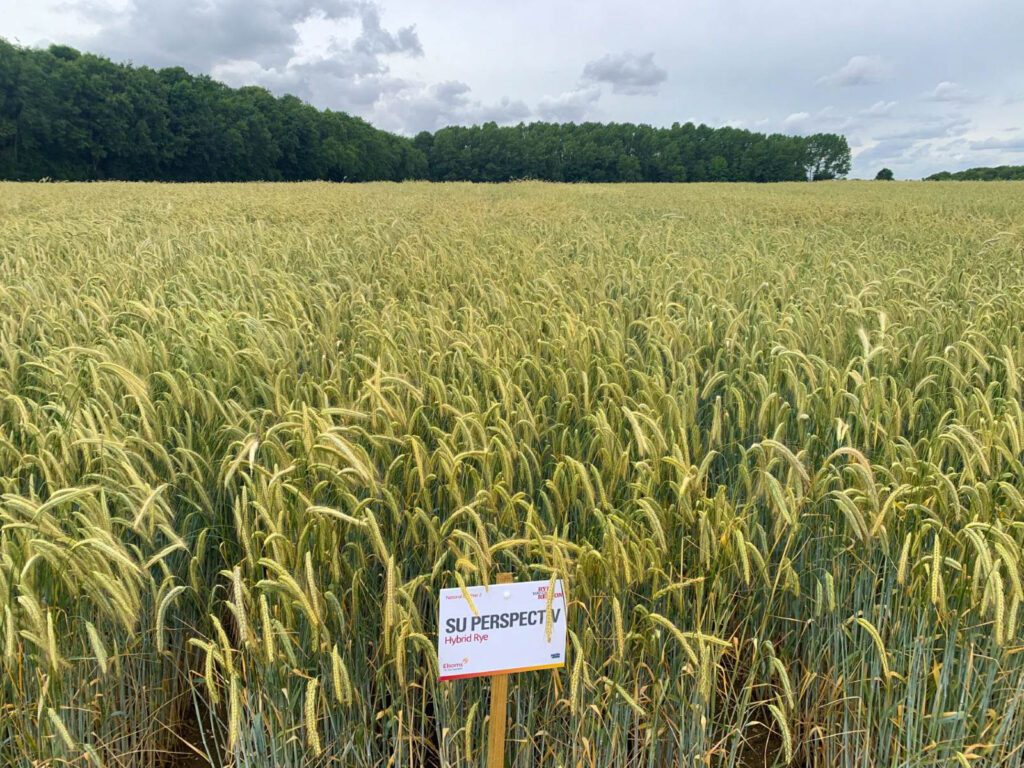Clear agronomic benefits predict “strong future” for hybrid rye
22nd May 2023
Integrated into arable rotations, hybrid rye offers significant agronomic benefits combined with market opportunities in the animal feed and distilling sectors, with experts predicting the UK rye area to double in size over the next few years.

SU Perspectiv from Saaten Union UK is promising to be a high-yielding rye variety with potential for the distilling sector.
According to Nigel Walley, national seeds manager for Agrovista UK, the current rye area of 50,000ha could easily double in size by 2028, due to the crop offering clear agronomic benefits as part of arable rotations, such as lower seed rates, rapid initial growth, outstanding water efficiency and an aggressive root system.
“Hybrid rye is an excellent choice for growers. It’s flexible in the rotation and can be drilled early or late, helping to spread the harvest. Its agronomic benefits (…) also equate directly into economic benefits for growers seeking to improve profit margins by lowering input costs,” he said.
Mr Walley, who has been commercially involved with hybrid rye since it first established itself as a key energy source for anaerobic digestion (AD) several years ago, added the crop needs only half the fertiliser of a second wheat and is much less susceptible to take-all, making it an attractive second cereal choice.
“On inputs it ticks all the key sustainability boxes and is relatively straightforward to manage when compared to other cereal crops. Apply a robust fungicide programme to combat any brown rust and ensure you apply 40% of N by growth stage 25 with the remaining 60% applied by growth stage 37.”
“With the majority of hybrid rye currently grown as wholecrop for AD, future growth in area will ultimately come down to development of new markets – particularly the distilling and pig feed sectors, and on seed breeders to continue developing new, higher-yielding varieties that meet the right physical and nutritional qualities specifically required by those markets,” he noted.
Key hybrid rye varieties
For growers looking to drill rye, Agrovista’s partners Saaten Union and Eldomd Seeds offer some strong hybrid varieties that grow well in UK conditions. Mr Walley explained the variety SU Performer has a track record of exceeding 50t/ha on wholecrop yields even in last year’s hot, dry conditions, with newer varieties such as SU Arvid also achieving good results.
“Both SU Performer and SU Arvid offer flexible drilling dates and consistently high yields, even when drilled in late November. Both varieties have low susceptibility to lodging, however you may still need to apply a Plant Growth Regulator (PGR) for insurance in very fertile conditions,“ Mr Walley concluded.
Sharing his vision for a rapidly expanding UK rye area, Andrew Creasy, cereal product manager for Saaten Union UK, is optimistic about the future of the crop.
“In 2022 we ran the first in a series of dedicated wholecrop trials that coincided with some demanding growing conditions during a very hot, dry year. Despite the challenging conditions, the ability of hybrid rye to shoot ahead and maximise early spring moisture was clearly demonstrated in the trials with several SU varieties still achieving fresh weight yields of over 60t/ha.
“If that 2022 summer was to be replicated regularly, then I can see a strong long-term sustainability argument for growing more rye. However, the key to unlocking more growing area in the short-medium term is establishing new markets,” he added.
“One potential new market could be bio-ethanol production. Although wheat is still the primary source for this, rye could do the job equally well – if not better, given rye’s lower inputs versus wheat.”
In the wholecrop trials, Mr Creasy said SU Arvid came out on top with yields consistently over 5t/ha above SU Performer and 1.5t/ha above SU Baresi. SU Arvid was another top performing variety when it comes to gas yields.
“In terms of new candidate varieties for the next Descriptive List (DL), SU Perspectiv achieved higher yields in on-farm trials in both the North of England and Scotland and looks one to follow as a high-yielding grain variety with potential for the distilling sector,” Mr Creasy concluded.
Meanwhile, Elsoms seed specialist Emily Pick sees a strong future for hybrid rye based on the pipeline of new SU candidate varieties and established SU varieties already on the DL.
She said: “Of the 11 hybrid rye varieties on the current DL, 6 are SU varieties with SU Baresi, SU Arvid and SU Perspectiv all receiving significant grower interest.
“With its excellent disease resistance to brown rust, SU Baresi has performed well in both trials and real farm situations recording a specific weight of 78.2kg/hl and achieving gas yields 6% higher than controls.
“SU Arvid has continued to exhibit the highest fresh weight output amongst all varieties in UK trials, and SU Perspectiv has shown yield consistency in cooler, less volatile growing conditions in Scottish trials. With good disease scores and excellent lodging resistance due to its lower plant height, it looks a strong addition to the portfolio” Ms Pick concluded.
